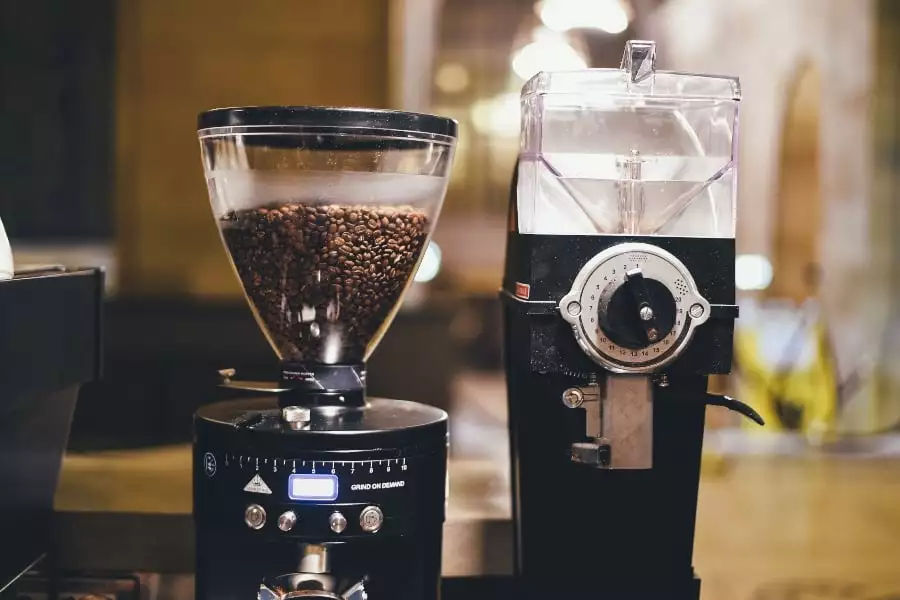In days gone by, you could only get a quality cup of coffee by visiting a barista. Today, though, you can make it yourself, from the comfort of the kitchen. All you need are the right tools. A coffee machine is obviously very important. You will also need a grinder. Here’s everything you need to know about using this tool.
Choosing Your Grinder
When you start looking for grinders, one thing will quickly become apparent. There are dozens of different options to choose from. You can get hand grinders or ones that require electricity. Generally, though, they can all be broken down into two varieties. You can either get blade or burr grinders. This describes the approach they take to grinding. Both of these techniques have their pros and cons.
Let’s start by talking about the blade grinder. It gets this name because of the size of the blade featured on the bottom of the grinder. In this area, it can be similar to a blender. The upside is that it is very easy to use. All you need to do is add the beans. Then, you can start grinding. The length of time you spend grinding will determine how coarse the beans will be.
However, the blade approach has a few big downsides. It can be difficult to get the consistency right. This can impact the taste of the coffee. Another potential issue is the static charge created by these devices. This can mean that the grounds will stick to the grinder.
The other option that you can explore is a burr grinder. In this case, the grounds will be drawn in between two burrs, where they are crushed. This approach ensures that all the grounds will be a uniform size. The biggest downside, though, is that it will take longer than a blade grinder. They also tend to be the more expensive option. This article goes into more depth about the differences between blade grinders and burr grinders.
While knowing whether you want a blade or burr grinder is a good start, it isn’t the only factor that you will need to consider. You’ll also have to think about how big the grinder will be and the amount of power it provides. For more tips and to research some of the most popular options, check out this coffee grinder list.
Start With Quality Coffee
While the grinder is important, the type of beans you are using is equally important. There are a few ways you can make sure that you are using quality beans. You will need to make sure that you get something that has the roasting date on the package. It’s also a good idea to experiment with flavors, finding the ones that you enjoy the most. The next thing that you need to do is store it properly. This will ensure that the beans don’t go stale. This article has some tips to help you do this.
Setting Up The Grinder
If you have just got the device, you’ll need to make sure that you have got the grinder set up properly. The good news is that this step is fairly easy. Sometimes, you might need to assemble it. For example, you might need to put a catcher underneath the grinder to catch the grounds. If you do, the manual will tell you what steps to follow. From there, you just need to plug it into the outlet. Sometimes, you will need to leave it running for a few minutes. This allows the blades to warm up.
Next, it’s time to add the beans. Be careful about the amount you are adding. If you want to grind a lot, it’s best to do it in batches. This ensures that you don’t overwhelm the machine. Before turning the machine on, make sure that the grounds are spread out. To keep the beans fresh, it’s recommended that you only grind them as required. Grounds will lose their flavor faster than beans will.
Decide The Type Of Grind
Now that we’ve got our grinder and our beans, it’s time to start the grinding process. The first thing we need to decide is the type of grind you want to use. This will depend on a few flavors. Most importantly, the type of machine you are using and the type of coffee you want.
If you are using a French press or pour-over, you’ll need to have coarser grounds. On the other hand, if you are using an espresso machine, you’ll need to have a fine grind. This will allow the steam to penetrate through the grounds and extract the flavor. It will need to have a similar consistency to flour. This article will go into more depth about the type of grind to use with each machine.
Often, the best way to get the right grind size is through trial and error. The flavor of the coffee will tell you whether you need to adjust the grind. If the coffee tastes too salty or sour, it means that the grind size is too big. As a result, you aren’t getting enough flavor from the bean. On the other hand, you might be over extracting the flavors because the grind is too fine. The best indication of this is when your coffee starts to taste too bitter.
Some machines might come with a stepped feature. This will make it easier for you to make minor adjustments to the grind size, so you can find the right option for you. At other times, you might be able to find a machine that has lots of grind settings, often depending on the type of drink you are making. In this case, getting the right grind will be as easy as pushing a button.
Try The Coffee
That’s it; you should have a delicious coffee grind. Now comes the true test. It’s time to try it out and see what you think. If this is your first time making a grind, don’t expect to get it perfect. But the best part about grinding your own coffee is that you’ll be able to customize it to suit your tastes.
As you are doing this, it might help to keep a journal of your experiences and the way the coffee tasted. This will make it easier to learn from past trials and find the ideal grind size for you. Furthermore, experiment with different types of beans. Each will one will have a slightly different flavor profile.
Cleaning The Grinder
Once you have finished grinding the beans, it’s time to clean out the machine. This will stop it from getting clogged up and breaking down. This type of maintenance can be broken down into two categories, short-term and long-term.
After each time using the grinder, you’ll need to grind away any excess coffee. Then, turn off the machine. You can then wipe around the inside with a damp cloth. This should remove any grounds that are trapped in the grinder.
However, there might come a time when the taste of the coffee is starting to be affected. This might be because of the build-up of oils from the beans. The good news is that there is an easy solution. Grind up some rice. The grains will absorb the oils from the coffee. When you are finished, you will need to thoroughly clean the grinder, wiping down the blades. This will remove any traces of the rice.
Another potential problem is the build-up of residue in the machine. To do this, you will need to thoroughly clean the machine. In this case, you will need to take off any removable components. In most cases, you will be able to put these into a dishwasher to clean them. Just make sure that you are using the gentle cycle. If you are concerned about them, you can wash them by hand. Just use some detergent and warm water.
As you are washing the components, you can clean out the inside of the grinder. To do this, you’ll need to use a damp, soft cloth. This should clean up any residue. You can also run a cloth around the base of the grinder. Don’t use any water at the base; you don’t want to risk damaging the electric elements.
Finally, you’ll need to dry the internal components thoroughly before you replace them. How often you’ll need to do this will depend on how often you use the coffee grinder. If you use it frequently, you might need to do a deep clean every fortnight. If not, you might only need to do it every month. You’ll know that it needs to be cleaned when your coffee is starting to taste bland.
Conclusion
Your coffee grinder will soon become one of the most popular items in your kitchen. These devices are highly customizable, so you’ll be able to create the ideal grind for your tastes. Hopefully, these tips will make it easier to get started using your coffee grinder.







